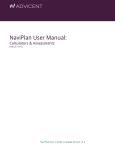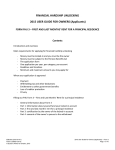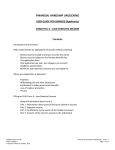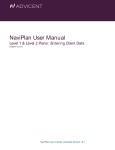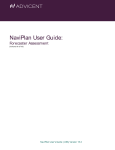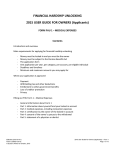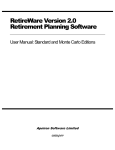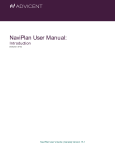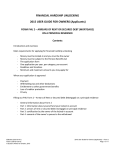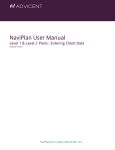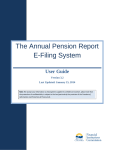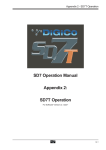Download NaviPlan User Manual: Forecaster
Transcript
NaviPlan User Guide: Forecaster Assessment (Volume III of VI) NaviPlan User's Guide: (Canada) Version 15.0 Copyright and Trade-mark © Copyright 2013-2014 Advicent LP and its affiliated companies (Advicent). All rights reserved. Advicent ® and NaviPlan ® are trade-marks of Advicent. No part of this publication may be reproduced or transmitted in any form, by any means (electronic, photocopying, recording, or otherwise) without the written permission of Advicent. Microsoft Word is a registered trade-mark of Microsoft Corporation. Adobe and Acrobat are trade-marks of Adobe Systems Inc. All other product names are the sole properties of their respective owners. Software Licence This publication is intended for use by authorized licencees of Advicent’s proprietary NaviPlan software described herein. This publication does not grant any licence or right to use of the software, and use of the software or this publication is prohibited by anyone who is not an authorized licencee. All licences, rights, and restrictions on use of the software are governed by a separate licence agreement. Disclaimer The software described in this publication is designed to allow a financial planner to demonstrate and evaluate various strategies in order to achieve a client’s financial goals. It is licenced to authorized licencees on the understanding that Advicent is not engaged in rendering legal, accounting, or other professional advice and, if any such advice is required, the services of a competent professional person should be obtained. Advicent has engaged Ibbotson Associates, Inc., a wholly owned subsidiary of Morningstar, Inc., to develop proprietary asset allocation tools for educational purposes. Ibbotson has granted to Advicent a licence for use thereof. Canadian version 11/24/2014 NaviPlan User Manual: Forecaster Assessment Contents Contents 0 NaviPlan User Guide Series ii Conventions iii NaviPlan Resources iv An Intro to the Forecaster Assessment 1 Assumptions 2 Selecting financial goals to assess 2 Selecting analysis methods 3 Entering inflation, tax, and historical assumptions 4 Clients' Financial Data 7 Entering assets and liabilities 7 Entering income and expenses 8 Entering savings and investments (Simple Retirement Analysis) 9 Entering savings and investments (Detailed Retirement Analysis) 10 Entering non-registered account information 10 Entering RRSP/RRSP Spousal account information 11 Entering TFSA account information 12 Entering defined contribution information 13 Entering LIRA information 14 Directing additional monthly savings to specific account types 14 Setting up the conversion of registered plans to retirement income funds 15 Converting an RRSP or spousal RRSP to a Registered Retirement Income Fund (RRIF) 16 Converting a defined contribution pension plan or a LIRA to a Life Income Fund (LIF) 17 Converting a registered plan to an annuity 18 Clients' Goals 19 Retirement 19 Entering retirement assumptions (Simple Retirement Analysis) 20 Page 0 of 5 NaviPlan User Manual: Forecaster Assessment Entering retirement assumptions (Detailed Retirement Analysis) 21 Education 23 Major Purchases 25 Clients' Insurance Coverage & Needs 27 Entering existing life insurance policies 27 Determining additional life insurance needs 28 Entering disability insurance coverage and disability income needs 30 Viewing goal coverage progress Tracking net worth and cash flow projections/Viewing goal coverage progress Preparing custom text for reports 31 32 33 Managing quick picks for user-defined text 34 Adding user-defined text to reports 34 Forecaster Client Reports 35 Creating a new report 36 Adding custom content to a report 36 Converting reports to Microsoft Word output 37 Creating a new report template 37 Using a template to create a report Index 37 38 Page i of 5 NaviPlan User Manual: Forecaster Assessment NaviPlan User Guide Series NaviPlan user guides are organized by the tasks you can accomplish in each level. If you are a new NaviPlan user, start with the Introduction user guide. User manual Introduction Calculators Forecaster Assessment Asset Allocation Assessment Level 1 and Level 2 Plans: Entering client data and goals Level 1 and Level 2 Plans: Analyzing client goals Tasks covered n Setting up user preferences. n Creating and managing client engagements. n Determining which assessment or plan level to select. n Using NaviPlan workflow. n Using calculators to model specific aspects of your clients’ finances. n Quickly assessing your clients’ current financial situation. n Entering account and annuity information. n Determining your clients’ investor profile. n Entering financial planning assumptions. n Entering detailed net worth, cash flow, and insurance information. n Adding holdings to accounts and annuities. n Entering saving and redemption strategies. n Entering client goals. n Generating client reports. n Analyzing your clients’ goals using Scenario Manager. n Conducting detailed cash flow and net worth analyses. n Generating Monte Carlo simulations. n Creating goal scenarios. n Generating client reports. Page ii of 5 NaviPlan User Manual: Forecaster Assessment Conventions This user guide uses the following conventions. n The names of items on the screen are bolded and italicized. For example, the Clients page opens. n The names of items that you must select, click, or enter appear in bold. For example, select Recommended, and then click OK. n To help you navigate through the application, locations are separated by en dashes (–). For example, Enter Financial Data section – Net Worth – Accounts. Enter Financial Data section – Net Worth category – Accounts page To help you use this guide, please note the following abbreviations and graphics: n AA – Refers to the Asset Allocation Assessment. n FA – Refers to the Forecaster Assessment. n – Indicates that the step or paragraph applies to Level 1 Plans only. n – Indicates that the step or paragraph applies to Level 2 Plans only. n – Indicates that the step or paragraph only applies when you are using the Average Tax method. n – Indicates that the step or paragraph only applies when you are using the Detailed Tax method. Page iii of 5 NaviPlan User Manual: Forecaster Assessment NaviPlan Resources Advicent provides several resources to help you use NaviPlan. The following table shows some of the resources available and where to find them. Advicent resource Description and location Help The quickest way to get information about any item within NaviPlan is to use the application Help. To access Help, select NaviPlan Help from the Help & Resources menu. Help includes a glossary of terms. Functional Documents Functional documents explain NaviPlan functionality, underlying assumptions, and results calculations. You can access functional documents on specific topics on the related page in the NaviPlan Learning Centre, or a list of all available functional documents on the Functional Documents page. Quick Reference Guides (QRGs) Quick Reference Guides are designed to get you started with a particular workflow in NaviPlan. You can access QRGs on specific topics on the related page in the NaviPlan Learning Centre, or a list of all available QRGs on the Quick Reference Guides page. User Guides You can also access other user guides in this series . You can access user guides on the User Guides page in the NaviPlan Learning Centre. Training Videos Training videos are designed to give you an overview of completing a specific task in NaviPlan. You can access videos on specific topics on the related page in the NaviPlan Learning Centre, or a list of all available functional documents on the Videos page. Take Action™ Webinars The Take Action™ webinar series helps you get the best return on your investment in NaviPlan by showing you how to apply the software to real world situations . You can access webinars on specific topics on the related page in the NaviPlan Learning Centre, or a list of all available functional documents on the Take Action Webinars page. Partner Support Contact us by telephone at (888) 692-3474 (Monday–Thursday, 7:30 a.m.–6 p.m. central time) (Friday, 7:30 a.m.-5:00p.m. central time) Contact us by email at [email protected] Page iv of 5 NaviPlan User Manual: Forecaster Assessment An Intro to the Forecaster Assessment NaviPlan's simplest planning level, formerly known as the Financial Assessment, has been upgraded with additional features, usability enhancements, and Next-Gen reporting! The upgrade provides such a new experience that we thought the level deserved a new name: the Forecaster Assessment. The Forecaster Assessment is a streamlined analysis perfect for new clients or for clients with simpler financial situations and goals. It was designed to follow the conversations you have with clients, to quickly obtain a picture of your clients’ current financial situation and to assess if their financial goals will be met. Why was the Financial Assessment planning level upgraded to the Forecaster Assessment? NaviPlan has always been noted for its adaptability — especially for high net worth clients. This update aims to make NaviPlan equally as friendly for clients on the other end of the spectrum or new clients who just want a quick financial overview: n Forecaster uses a more intuitive data-entry flow and allows you to dive deeper into insurance needs. n Forecaster brings an entirely new set of client reports that are easier to understand. Reports are still as detailed and configurable, but much more client-friendly. n Any client information saved in a Financial Assessment is still available in the Forecaster Assessment. It's a fresh perspective on the same data. What are the differences in the Forecaster Assessment? n Forecaster uses the left-hand navigation bar to bring it closer to the layout of Level 1 and Level 2 plans. n Survivor Income and Disability Income have been separated to allow for more in-depth discussions about life insurance needs. n Income & Expenses, Assets & Liabilities, and Savings & Investments now have individual pages. o Retirement investment accounts are now entered on the Savings & Investments page rather than the Retirement page. n Forecaster introduces the popular Next-Gen report format to a lower planning level. Reports are still as detailed and configurable, but much more client-friendly now. n Real-time goal coverage progress is now available from the Quick Actions menu under Current Results and on each goal page by clicking Current Results. Page 1 of 43 NaviPlan User Manual: Forecaster Assessment Assumptions Selecting financial goals to assess The Select Modules page displays the assessment’s modules and available options. Forecaster Assessment section – Forecaster Assessment category – Select Modules page (Average Tax method selected) To change the selected modules, go to the Select Modules page, and then click Select Modules. A dialog box opens where you can clear or select modules. Select Modules dialog box Page 2 of 43 NaviPlan User Manual: Forecaster Assessment Selecting analysis methods Two types of tax methods are available in Forecaster Assessments: Average Tax and Detailed Tax. Average Tax Method: When the Average Tax method is used, average tax rates (including province tax rates specified on the Settings menu – Plan Settings – General tab) apply to income during three different time periods: pre-retirement, retirement, and in the year of death. The tax rates can be edited on the Assumptions page. If you selected the Average Tax method during assessment creation, you can convert to the Detailed Tax method by clicking Convert to Detailed Income Tax on the Select Modules page. Once you have converted to the Detailed Tax method, you cannot revert to the Average Tax method. Detailed Tax Method: When using the Detailed Tax method, NaviPlan applies the bracketed federal and province rates (including tax deductions and credits), to taxable income on a year-by-year basis. These tax rates are not editable. Retirement Methods: The Retirement module can either be Simple or Detailed. To enter specific details for the clients’ government benefits or defined benefit pension benefits, model retirement accounts such as spousal RRSPs, defined contribution pension plans, and locked-in retirement accounts (LIRAs), or specify to which account type (nonregistered, RRSP, or RRSP spousal) additional savings should be directed, click Convert to Detailed Retirement. To use the detailed retirement mode, click Convert to Detailed Retirement on the Select Modules page. OR Select the Detailed option in the Plan Creation – Modules stage during assessment creation. Note: Assessments that have been converted to Detailed Retirement cannot be reverted to Simple Retirement. Page 3 of 43 NaviPlan User Manual: Forecaster Assessment Entering inflation, tax, and historical assumptions On the Assumptions page using the Average Tax method, you can specify the base inflation rate and the income tax brackets before and during retirement, and in the year of death. The tax rate for dependants can also be defined. On the Historical Data tab, you can also specify amounts that will affect RRSP contributions, such as the previous year’s income or pension adjustments. You can also enter TFSA and RESP contributions. To enter the clients’ inflation, tax, and historical assumptions, follow these steps: 1. Go to the Assumptions page. 2. To view a graph of historical inflation rates, click Inflation Rate Graph under Economic Factors. By default, the graph displays inflation rate information from 1915 to the present. You can show inflation rates for the last 25 years or the last 10 years by clicking the links under Select a Graph to View. Forecaster Assessment section - Assumptions page - General tab - Inflation Rate Graph dialog box 3. To change the inflation rate, enter a different percentage in the Base Inflation Rate field. Forecaster Assessment section - Assumptions page - General tab - Economic Factors section 4. Under Tax Rates, select the appropriate taxable income range from the Tax Bracket menu. NaviPlan automatically populates the Average and Marginal tax rate fields for the defined income. You can override the calculated rates by entering the desired rates into the appropriate fields. If any of the rates change, an arrow appears beside each edited tax rate to remind you that it has been modified. Page 4 of 43 NaviPlan User Manual: Forecaster Assessment Note: When using the Detailed Tax method, the Tax Rates section is not available as NaviPlan applies bracketed federal and provincial taxes, which consider an extensive number of deductions and credits. 5. If your client intends to become a resident of a different province during their retirement, under Future Province of Residence, do the following: a. Select Override. b. From the Province menu, select the province where your client will reside in the future. c. Enter the Average Tax Rate for the client, co-client and any dependants. 6. To enter historical RRSP, TFSA, and RESP contribution information, go to the Historical Data tab. Forecaster Assessment section – Assumptions page – Historical Data tab – RRSP Contributions tab (Detailed Tax method) 7. To enter historical RRSP information, go to the RRSP Contributions tab. n Enter the clients’ previous year’s income. n If either of the clients are a member of a pension plan at work, enter the pension adjustment amount (from the T4 statement). This value will be deducted from the allowable limit. n If either of the clients have an outstanding overcontribution balance, enter the overcontribution amount in the RRSP Overcontribution Balance field. This value will be deducted from the allowable limit for the current year. n If either of the clients have not made contributions that meet their maximum allowable contribution, enter the RRSP deduction carryforward amount from the client’s Notice of Assessment. This value is added to the allowable limit for the current year. 8. If the client withdrew funds from an RRSP to participate in the Home Buyers’ Plan, under Home Buyers’ Plan - RRSP Repayments, enter the remaining balance in the HBP Balance Owing field. If the value is left at $0, NaviPlan assumes that no loan exists. In the Years Left to Repay field, enter the number of years the client has to repay the balance (must be less than 16 years). In the Begin Repayments In field, enter the year in which the repayments must begin. Page 5 of 43 NaviPlan User Manual: Forecaster Assessment Forecaster Assessment category – Assumptions page – Historical Data tab – TFSA Contributions tab 9. To enter historical TFSA information, go to the TFSA Contributions tab. n If either of the clients have an outstanding TFSA overcontribution balance, enter the overcontribution amount in the TFSA Overcontribution Balance field. This value will be deducted from the allowable limit for the current year. n If either of the clients have not made TFSA contributions that meet their maximum allowable contribution, enter the TFSA deduction carryforward amount from the client’s Notice of Assessment. This value is added to the allowable limit for the current year. Forecaster Assessment category – Assumptions page – Historical Data tab – RESP Contributions tab 10. To enter historical RESP contributions, go to the RESP Contributions tab. You can manually track your clients’ RESP contributions, their CESG eligibility, total CESG payment received, and net income for the previous year. Page 6 of 43 NaviPlan User Manual: Forecaster Assessment Clients' Financial Data Entering assets and liabilities Forecaster section – Assets & Liabilities To enter clients' current assets and liabilities, follow these steps: 1. Go to the Assets & Liabilities page. 2. Under Assets, enter the current value of each asset by category. NaviPlan will provide the Total below. 3. Under Liabilities, enter the outstanding amount, interest rate, and monthly payment amount for each liability by category. NaviPlan will provide the Total below. Page 7 of 43 NaviPlan User Manual: Forecaster Assessment Entering income and expenses Forecaster section – Incomes & Expenses To enter clients' current annual income and monthly expenses, follow these steps: 1. Go to the Income & Expenses page. 2. Under Annual Income, enter the Annual Income and the Estimated Annual Pension Income for the client and co-client. 3. Under Monthly Expenses, enter the monthly expense amounts either by individual category or as one summary expense in the Other field. NaviPlan will provide the Total below. Note: The last four fields are greyed-out and unavailable. These values are entered on the Assets & Liabilities page. Page 8 of 43 NaviPlan User Manual: Forecaster Assessment Entering savings and investments (Simple Retirement Analysis) Forecaster section – Savings & Investments To enter clients' current investments and savings, follow these steps: 1. Go to the Savings & Investments page. 2. Enter the Current Value and Current Monthly Savings amounts for the client and co-client's individual registered accounts, as well as for their individual and joint non-registered accounts. 3. Enter the Assumed Return Rate for all accounts. Page 9 of 43 NaviPlan User Manual: Forecaster Assessment Entering savings and investments (Detailed Retirement Analysis) Entering non-registered account information To enter non-registered account information, follow these steps: 1. On the Savings & Investments page, go to the Non-Registered tab. Forecaster section – Savings & Investments – Non-Registered tab (Detailed retirement mode) 2. Enter the current value of each client’s individually owned and jointly owned non-registered accounts. 3. Enter monthly savings that will be contributed to the non-registered accounts. 4. Click the Return Rate links to open the Return Rates dialog box. Return Rates dialog box 5. Under Pre-Retirement and Retirement, enter the percentage of interest, dividends, capital gains, and deferred growth for each return rate. Page 10 of 43 NaviPlan User Manual: Forecaster Assessment Entering RRSP/RRSP Spousal account information To enter the clients’ RRSP and RRSP Spousal account information, follow these steps: 1. On the Savings & Investments page, go to the RRSP or RRSP Spousal tab. Forecaster section – Savings & Investments – RRSP tab (Detailed retirement mode) 2. Enter the current value of each client’s RRSP or RRSP Spousal account. 3. Enter monthly savings that will be contributed to the registered accounts. 4. To set up the conversion to a retirement income fund, click Details. Note: For help with the conversion to a retirement income fund, see Converting an RRSP or spousal RRSP to a Registered Retirement Income Fund (RRIF) on page 16. 5. Enter the Assumed Return Rate for the pre-retirement and retirement periods. Page 11 of 43 NaviPlan User Manual: Forecaster Assessment Entering TFSA account information To enter the clients’ TFSA information, follow these steps: 1. On the Savings & Investments page, go to the TFSA tab. Forecaster section – Savings & Investments – TFSA tab (Detailed retirement mode) 2. Enter the current value of each client’s TFSA. 3. Enter monthly savings that will be contributed to the TFSA. 4. Enter the Assumed Return Rate for the pre-retirement and retirement periods. Page 12 of 43 NaviPlan User Manual: Forecaster Assessment Entering defined contribution information To enter the clients’ defined contribution information, follow these steps: 1. On the Savings & Investments page, go to the Defined Contribution tab. Forecaster section – Savings & Investments – Defined Contribution tab (Detailed retirement mode) 2. Enter the current value of each client’s registered pension plans (RPP money purchase plan type). 3. Enter the monthly employee and employer savings that will be contributed to the clients’ registered pension plans. 4. To enter conversion details, click Details. Note: For help with the conversion to a retirement income fund, see Converting a defined contribution pension plan or a LIRA to a Life Income Fund (LIF) on page 17. 5. Enter the Assumed Return Rate for the pre-retirement and retirement periods. Page 13 of 43 NaviPlan User Manual: Forecaster Assessment Entering LIRA information To enter the clients’ locked-in retirement account (LIRA) information, follow these steps: 1. On the Savings & Investments page, go to the LIRA tab. Forecaster section – Savings & Investments – LIRA tab (Detailed retirement mode) 2. Enter the current value of each client’s LIRA. 3. To enter conversion details, click Details. Note: For help with the conversion to a retirement income fund, see Converting a defined contribution pension plan or a LIRA to a LIF on page 1. 4. Enter the Assumed Return Rate for the pre-retirement and retirement periods. Directing additional monthly savings to specific account types On the Savings & Investments page, under Savings Settings, select the account types to which additional monthly savings will be directed. Page 14 of 43 NaviPlan User Manual: Forecaster Assessment Setting up the conversion of registered plans to retirement income funds In a Forecaster Assessment, you can set up the conversion of the following registered plans to retirement income funds: n Registered retirement savings plans (RRSP) or spousal RRSPs can be converted to registered retirement income funds (RRIFs). n Defined contribution pension plans or locked-in retirement accounts (LIRAs) can be converted to a life income fund (LIF). n All registered plan types can be converted to an annuity. Page 15 of 43 NaviPlan User Manual: Forecaster Assessment Converting an RRSP or spousal RRSP to a Registered Retirement Income Fund (RRIF) 1. On the Investments & Savings page, go to the RRSP or RRSP Spousal tab. 2. Click Details. Account Setup dialog box (Convert to RRIF) 3. Under Convert to RRIF, define when the RRSP will be converted. If you select At Age, specify the age when the RRSP will be converted. Note: Conversion must take place by age 71 at the latest. 4. To use the younger client’s age to calculate RRIF minimum payments, select the Use younger partner’s age for minimums option. 5. From the Minimum Payment Frequency menu, select Monthly or Annual. If you selected Annual, select the payment month from the Make Annual Payments In menu. 6. Click OK. Page 16 of 43 NaviPlan User Manual: Forecaster Assessment Converting a defined contribution pension plan or a LIRA to a Life Income Fund (LIF) 1. On the Savings & Investments page, go to the Defined Contribution or LIRA tab, and then click Details. Note: The LIF option is selected by default, and the LRIF option is no longer accessible. This is due to recent legislative changes where existing LRIFs are being converted to LIFs. Account Setup dialog box (Convert to LIF) 2. Under Conversion Preference, indicate when the plan is to be converted. To specify the age, select At Age, and then enter the age. 3. To use the maximum payout amount, select the Use maximum payout amount option. Note: This option is not accessible if Automatic was selected under Conversion Preference. 4. Select the governing legislative area. 5. From the Minimum Payment Frequency menu, select Monthly or Annual. If you selected Annual, select the payment month from the Make Annual Payments In menu. 6. Click OK. Page 17 of 43 NaviPlan User Manual: Forecaster Assessment Converting a registered plan to an annuity Note: All registered plan types can be converted to annuities except for Registered Education Savings Plans (RESPs). 1. On the Savings & Investments page, go to the <registered plan> tab, and then click Details. 2. Click the Annuity Information (Optional) link. 3. Select the Convert to Annuity option. 4. Specify the age when the plan is to be converted. Note: Annuity legislation is constantly changing. In some legislative jurisdictions, conversion is mandatory at age 80, while in other areas 90 is the mandatory age. Some jurisdictions have removed this restriction all together and leave it to the plan owner to decide when best to convert to an annuity. It is up to you to ensure that the applicable legislation is followed. 5. Enter the expected annuity return rate. 6. Click OK. Note: Accounts converted to a life annuity do not carry over to the spouse should the owner die. Page 18 of 43 NaviPlan User Manual: Forecaster Assessment Clients' Goals Retirement Here is a summary of the considerations NaviPlan makes to analyze retirement goals in a Forecaster Assessment: Retirement Dates n Retirement begins on the date specified for the first client to retire. n Retirement ends December 31 of the year when the last client dies. n NaviPlan assesses needs in each year of the retirement period and compares them to the resources available for retirement funding. If either a shortfall or overfunding is expected, NaviPlan presents recommendations. Retirement Needs n Include desired annual retirement income and liability payments that extend into the retirement period n Do not include taxes or life insurance premiums. o n NaviPlan calculates taxes automatically; insurance premiums are entered on the Life Insurance page. Lifestyle assets, such as homes, are not sold to fund retirement needs. Retirement Resources n Include estimated annual pension income, Canada/Quebec pension plan and Old Age Security benefits, and all registered and non-registered accounts. Two modes of data-entry are available for the Retirement module: Simple and Detailed. n Simple retirement mode – NaviPlan assumes that the clients are 100% eligible for CPP/QPP and OAS benefits starting at retirement. You can enter summary information about the clients’ registered accounts (which NaviPlan converts to RRIFs at retirement) and non-registered retirement accounts. n Detailed retirement mode – You can enter specific details for the clients’ CPP/QPP and OAS benefits or defined benefit pension benefits, model retirement accounts such as spousal RRSPs, defined contribution pension plans, or LIRAs, enter details for the conversion of assets to retirement income funds, and specify to which account type (RRSP, RRSP Spousal, TFSA, or non-registered) additional savings should be directed. To use the detailed retirement mode, you must either: n Click Convert to Detailed Retirement on the Financial Assessment section – Select Modules page. OR Select the Detailed option on the Plan Creation dialog box – Modules screen during assessment creation. Page 19 of 43 NaviPlan User Manual: Forecaster Assessment Entering retirement assumptions (Simple Retirement Analysis) Forecaster section – Retirement To enter the assumptions to use for your clients' retirement goals, follow these steps: 1. Go to the Retirement page. 2. Under Retirement Information, enter the Retirement Age and the Life Expectancy for the client and coclient. 3. Under Retirement Needs, select one of the following options: n Percentage of Current Income: NaviPlan calculates the percentage of the household income that you entered on the Incomes & Expenses page and uses this amount as their retirement income need for the entire duration of the retirement period. n Monthly Need (in today's dollars): Manually enter up to three phases during which the clients' retirement income need will be based off of the dollar amount that you enter. Each phase will begin when the first client to retire reaches the specified age. Page 20 of 43 NaviPlan User Manual: Forecaster Assessment Entering retirement assumptions (Detailed Retirement Analysis) Forecaster section – Retirement To enter the assumptions to use for your clients' retirement goals, follow these steps: 1. Go to the Retirement page. 2. Under Retirement Information, enter the Retirement Age and the Life Expectancy. 3. Indicate the clients' benefit eligibility by selecting the CPP/QPP Eligibility and/or the OAS Eligibility options. Page 21 of 43 NaviPlan User Manual: Forecaster Assessment 4. To specify CPP/QPP & OAS benefit information, such as the Benefit Amount, Benefit Start Age, OAS Deferred Benefit Bonus and the Index Rate, click Details. CPP/QPP & OAS Details dialog box 5. Under Retirement Needs, select one of the following options: n Percentage of Current Income: NaviPlan calculates the percentage of the clients' current income that you entered on the Incomes & Expenses page and uses this amount as their retirement income need for the entire duration of the retirement period. n Monthly Need (in today's dollars): Manually enter up to three phases during which the clients' retirement income need will be based off of the dollar amount that you enter. Each phase will begin when the first client to retire reaches the specified age. Page 22 of 43 NaviPlan User Manual: Forecaster Assessment Education NaviPlan compares all needs associated with the education goal for each dependant to the resources available for education funding. If a shortfall or overfunding is expected, NaviPlan presents recommendations for each education goal. In the Forecaster Assessment, each dependant can have one education goal. In the Forecaster Assessment, education assessments can only be done for dependants; they cannot be done for the client or co-client. If no dependant was added when the client file was created, go to the Client Management – Client Information – Personal Information page, and then add the family member. Forecaster section – Education To enter the assumptions to use for your clients' education goals, follow these steps: 1. Go to the Education page. 2. Under Education Objectives, enter: n the estimated annual education costs in today’s dollars. o You can click to search for the cost of attending a specific North American school. n a percentage to index costs by. n the dependant’s age when the education goal begins. the duration of the education goal. NaviPlan calculates the Total Projected Cost value by indexing each annual cost individually by the rate n entered in the Index Costs by field from January 1 of the assessment year to December 31 of the year prior to the last year of the education goal. Page 23 of 43 NaviPlan User Manual: Forecaster Assessment 3. Under Investment Accounts for Education, enter the current amount saved, the current monthly savings, and the assumed rate of return. n Savings earn the return specified in the Assumed Return Rate field until the account is depleted. n Non-registered savings are assumed to be deposited into a joint non-registered account. n For RESP accounts, NaviPlan automatically calculates and includes the 20% Canada Education Savings Grant (CESG) for Current Monthly Savings and this is reflected in goal coverage. n The amounts in the Current Amount Saved fields are assumed to be saved on January 1 of the plan year, whereas monthly savings begin in the current month. The monthly savings end on December 31 of the year before the last year of the goal. Page 24 of 43 NaviPlan User Manual: Forecaster Assessment Major Purchases NaviPlan compares all needs associated with the major purchase goal to the resources available to fund major purchases. If a shortfall or overfunding is expected, NaviPlan will present suggestions to attain 100% goal coverage. In the Forecaster Assessment, you can enter up to three major purchase goals. Forecaster section – Major Purchase To enter the your clients' major purchase goals, follow these steps: 1. Go to the Major Purchase page. 2. Under Major Purchase Objectives, enter: n the description. n the purchase date. n the current value of the cost. the cost index rate. NaviPlan calculates the Total Projected Cost value by indexing each annual cost individually by the rate n entered in the Index Costs by field from January 1 of the assessment year until the month prior to the the purchase month. Page 25 of 43 NaviPlan User Manual: Forecaster Assessment 3. Under Investment Accounts for Major Purchase, enter the current amount saved, the current monthly savings, and the assumed rate of return. n All amounts saved earn the rate of return specified in the Assumed Return Rate field until the account is depleted. n Accounts used to save toward major purchase goals are assumed to be joint, non-registered accounts or TFSAs. n The amounts in the Current Amount Saved fields are assumed to be saved on January 1 of the plan year, whereas monthly savings begin in the current month. The monthly savings end on the last day of the month prior to the the purchase month. Page 26 of 43 NaviPlan User Manual: Forecaster Assessment Clients' Insurance Coverage & Needs Entering existing life insurance policies Forecaster section – Life Insurance To enter clients' existing life insurance policies, follow these steps: 1. Go to the Life Insurance page. 2. Enter a Description for the life insurance policy. 3. Select the Insured client, Policy Type, and Beneficiary. 4. Enter the Benefit amount and monthly Premium for all existing life insurance policies. 5. Under Cease Coverage, specify either an age or a specific date at which the life insurance policy will end. Page 27 of 43 NaviPlan User Manual: Forecaster Assessment Determining additional life insurance needs To determine clients' life insurance needs, follow these steps: 1. Go to the Survivor Income page. 2. Select the scenario for which to run the quick assessment: n If the Client dies n If the Co-Client dies n If Both die 3. To include the calculated life insurance amount as a Survivor Income goal for your clients, select Include in Analysis. Forecaster section – Survivor Income (if Client dies) – Lump Sum Needs container 4. In the Lump Sum Needs container, enter the amount your clients would like to save in their Emergency Fund and the anticipated amount of their Final Expenses. n NaviPlan automatically includes any liabilities and the cost of any Education goals entered elsewhere in the assessment. To use different values, select Lump Sum Needs Override. 5. In the Ongoing Needs container, do one of the following: n If you are fairly certain what the clients' ongoing needs would be in the event of a premature death, enter either a dollar amount or a percentage of their current household income under $ or % of Salary and the number of years to which the needs apply. n To calculate the amount of income that would be lost and the new expenses that would arise from a death, click to open the Ongoing Needs calculator. Page 28 of 43 NaviPlan User Manual: Forecaster Assessment Forecaster section – Survivor Income (if Client dies) – Ongoing Needs container – Calculate button – Ongoing Needs dialog box 6. In the Available Assets to Offset Needs container, NaviPlan displays any assets that the survivor could sell to offset the immediate needs following the spouse's death, as well as the value of any existing life insurance policies. To use different values, select Available Asset Override. Forecaster section – Survivor Income (if Client dies) – Available Assets to Offset Needs container Forecaster section – Survivor Income (if Client dies) – Ongoing Incomes container 7. In the Ongoing Incomes container, you can select to Include Incomes as Entered in Plan (on the Incomes & Expenses page) and/or Include CPP/QPP and OAS to include these values in the Survivor Income analysis. 8. In the Assumptions container, enter the Inflation Rate, Assumed Return Rate and the Survivor's Tax Rate. 9. NaviPlan displays the total recommendation for additional life insurance in the Results container. If there are instances in the survivorship cash flow where surpluses will be available in the future but are not available to cover expenses today, you will see a line for Present Value Adjustments to account for these. Page 29 of 43 NaviPlan User Manual: Forecaster Assessment Entering disability insurance coverage and disability income needs Disability policies in the Forecaster Assessment are assumed to provide non-taxable flat dollar amounts that are not indexed for inflation. The owner of the policy is expected to pay for the premiums and be the recipient of disability benefits. Forecaster section – Disability Income To enter the your clients' existing disability insurance policies, follow these steps: 1. Go to the Disability Income page. 2. Enter the Income Need in Event of Disability, either as a percentage of current household income or a specific dollar amount. 3. For any short-term and long-term coverage, enter the following: n a description. n the insured client. n the policy type. n the monthly benefit amount. n the monthly premium amount. n the waiting period. n the benefits period. Page 30 of 43 NaviPlan User Manual: Forecaster Assessment Viewing goal coverage progress NaviPlan allows you to quickly view Current Results for clients' projected net worth, cash flow, and goal coverage progress based on the information you have entered in the analysis so far. It also recommends steps that clients could take to achieve 100% goal coverage. Current Results are available for the following goal types: n Retirement n Education n Major Purchase n Survivor Income n Disability Income Note: The actual goals that appear your screen will depend on the modules you selected on the Modules screen during goal creation. Page 31 of 43 NaviPlan User Manual: Forecaster Assessment Tracking net worth and cash flow projections/Viewing goal coverage progress To track projections of clients' net worth and cash flow or to view their goal coverage progress, follow these steps: 1. Go to the Quick Actions menu and select Current Results. 2. Select either the Net Worth or Cash Flow tab to view projections of the clients' financial situation. 3. Select a tab for one of the goals for which you would like to view the coverage. n The goal coverage graphs are interactive - hover over a bar to the view the details for that particular year. n You can click on labels in the graph key to hide or display the associated category from the graph. 4. View suggested methods to achieve 100% goal coverage under Options to Increase Goal Coverage. 5. Once you've reviewed your clients' progress and the suggested options to increase coverage, click Close to return to where you left off. Current Results dialog box – Education tab Page 32 of 43 NaviPlan User Manual: Forecaster Assessment Preparing custom text for reports In NaviPlan, you can create and customize text that will be included in reports. Personalize your plans and presentations by entering text on goal progress, recommendations, and any specific action items you would like clients to pursue. To enter personalized text for reports, follow these steps: 1. Go to the Reports – User Defined Text page. 2. Under Objectives, Recommendations, or Action Plan, click Add. User Defined Text Entry dialog box 3. Enter the text in the dialog box, and then use the formatting buttons where applicable. Note: A spelling checker is not available. Use your browser's spell-check or copy and paste plain text from Microsoft Word. Graphics are not supported. 4. If you would like to use this text across multiple plans or with multiple clients, select the Save to my Quick Picks for future use option. 5. When you are finished, click OK. 6. To edit an existing entry, click to reopen the User Defined Text Entry dialog box for that entry. 7. To reorder entries within a category, click Move Up or Move Down. 8. Repeat steps 2– until all your entries are complete. Page 33 of 43 NaviPlan User Manual: Forecaster Assessment Managing quick picks for user-defined text To access and manage any existing quick picks, follow these steps: 1. On the User-Defined Text page, click Manage My Quick Picks. 2. A list of all quick picks saved for the goal or category will appear. n To add a new quick pick, click Add. n To edit the content of an existing quick pick, click n To delete a quick pick, click . . 3. Once you've finished managing your quick picks, click OK. Adding user-defined text to reports To add your user-defined text to Next-Gen reports, follow these steps: 1. Go to the Reports – Client Reports page. 2. On the Select Report page, select either an existing template or click Start a New Report. 3. From the Select a category menu, select Supplementary Pages. 4. Depending on the type(s) of user-defined text you entered (Objectives, Recommendations, or Action Plan), a report page will appear under the End of Report section. 5. Click Add to include the page(s) containing your user-defined text in the report. Page 34 of 43 NaviPlan User Manual: Forecaster Assessment Forecaster Client Reports Client reports can be accessed from the Results – Client Reports section. Results category – Client Reports – Select Reports page Term Definition Report Page A report page is a single topic. Each tile on the Build Report page adds pages to your report. Report A report is a collection of report pages. After you have added each of the report pages you wish to present to your clients on the Build Report page, the output is called a report. Template A template is a report that has been saved for multiple uses. By saving reports as a template you can present the same set of report pages to all of your clients saving you time and ensuring consistency. Report Pages can be viewed as tiles or panels by selecting either or at the top of the page. Tile View ( ) Panel view ( ) Page 35 of 43 NaviPlan User Manual: Forecaster Assessment Creating a new report For a guided walkthrough to help you get started, on the Build Report page, click Getting Started above the Selected Pages panel. You're also welcome to send us your suggestions by clicking Feedback. Follow these steps to create a new report: 1. From the Select Report page, select Start a New Report. 2. Use the Select a category menu to display a list of report pages for each category. 3. Report pages are displayed as tiles. Select Add for each tile you want to include in your report. To remove a tile, select Remove. n Report tiles are categorized by the following sections: o Content: Dataless pages that provide an overview of the financial topic at hand. These provide context to reports and relate plans in a way that clients can understand. o Summary: Pages that cover clients' progress toward achieving their goal based on their current situation. These contain easy follow graphs and images. o Current Plan: Pages that summarize data for each goal in the current plan. These pages are numbers-oriented and often contain projection tables. 4. Review the order of report pages in the Selected Pages panel. The order displayed here matches the order in which reports will appear when generated. n To edit the position of report pages, drag and drop the page titles into the order you would like. Tip: You can quickly select all report pages on the Selected Pages panel by clicking the Select All link. 5. When you are satisfied with these options, select Build Report. Tip: If you run out of space on the Select Pages panel, you can select Expand the panel. to enlarge Adding custom content to a report Follow these steps to add your own supplementary content (e.g. client's wills, other estate planning documents, etc.) in PDF format to a report: 1. From the Build Report page, select the Custom Content report tile. 2. Use the Choose File button to find your custom PDF. 3. Enter a Title for the custom content. 4. When you are satisfied with these options, click OK. Note: The following requirements apply: n Maximum of 1 PDF per report (10MB or less). Page 36 of 43 NaviPlan User Manual: Forecaster Assessment Converting reports to Microsoft Word output Follow these steps to convert any generated report into a Microsoft Word (.docx) export file: 1. Select the pages to include in your report, then click Build Report. 2. Once the report is generated a blue bar appears near the top of the page. From this bar, click Convert to Microsoft Word to generate the report in Word format. Creating a new report template Follow these steps to create a new template: 1. From the Select Report page, select Start a New Template. 2. Select to enter a name and description for the template. 3. Use the Select a category menu to display a list of report pages for a category. 4. Report pages are displayed as tiles. Select Add for each tile you want to include in your template. To remove a tile, select Remove. n Report tiles are categorized by the following sections o Current Plan: Pages that summarize data for the current plan. These pages are numbersoriented and often contain projection tables. 5. Review the order of report pages in the Selected Pages panel. The order displayed here matches the order in which reports will appear when generated. n To edit the position of report pages, drag and drop the page titles into the order you would like. 6. When you are satisfied with these options, select Save. n If you have not yet entered a name for your template, you will be prompted to do so now. Using a template to create a report Follow these steps to generate a report using an existing template: 1. From the Select Report page, find the template you want to use to create a report and select Use. 2. When you are satisfied with these options, select Build Report. Page 37 of 43 NaviPlan User Manual: Forecaster Assessment Index A accessing Help iv accounts defined contribution plans 13 LIRA 14 RRSP 11 TFSA 12 assets 7 assumptions changing province of residence 5 general 4 inflation rate 4 retirement, detailed retirement 21 retirement, simple retirement 20 tax brackets 4 tax rates 4 Average Tax method iii, 3 C client reports adding custom content pages 36 adding custom text 34 converting to Microsoft Word 37 creating new reports 36 creating new templates 37 custom text 33 Page 38 of 43 NaviPlan User Manual: Forecaster Assessment customizing 33 display modes 35 overview 35 conventions, user manual iii converting defined contribution plans to LIF 17 LIRA to LIF 17 registered plans to annuities 18 registered plans to retirement income funds 15 RRSP to RRIF 16 criteria education 23 major purchases 25 retirement 19 current results goal coverage 31 options to increase goal coverage 32 custom text adding to reports 34 creating 33 managing Quick Picks 34 saving Quick Picks 33 D detailed retirement mode converting registered plans to retirement income funds 15 defined contibution plans 13 LIRA 14 RRSP 11 Page 39 of 43 NaviPlan User Manual: Forecaster Assessment savings preferences 10 TFSA 12 Detailed Tax method iii, 3 disability insurance existing policies 30 E education overview 23 savings 24 expenses 8 F financial goals 19 current results 31 education 23-24 major purchase 25-26 options to increase goal coverage 32 retirement 19-21 Forecaster Assessment overview 1 H Help, accessing iv I incomes current annual income 8 disability income 30 survivor income 27 Page 40 of 43 NaviPlan User Manual: Forecaster Assessment inflation historical rates 4 set base rate 4 investments 9 L liabilities 7 life insurance calculating additional needs 27 existing policies 27 LIRA 14 M major purchases overview 25 savings 26 modules selecting 2 N needs disability insurance 30 life insurance 27 P phone support iv R registered pension plans 13 resources phone support iv Page 41 of 43 NaviPlan User Manual: Forecaster Assessment training iv RESP 24 past contributions 6 retirement assumptions, detailed retirement 21 assumptions, simple retirement 20 overview 19 retirement modes detailed retirement 19 explanation of differences 19 simple retirement 19 RRSP 11 past contributions 5 S savings education 24 major purchases 26 retirement 9 savings preferences 10 T tax methods Average 3 Detailed 3 tax rates entering 4 TFSA 12 past contributions 6 Page 42 of 43 NaviPlan User Manual: Forecaster Assessment U user manual conventions iii series ii Page 43 of 43




















































